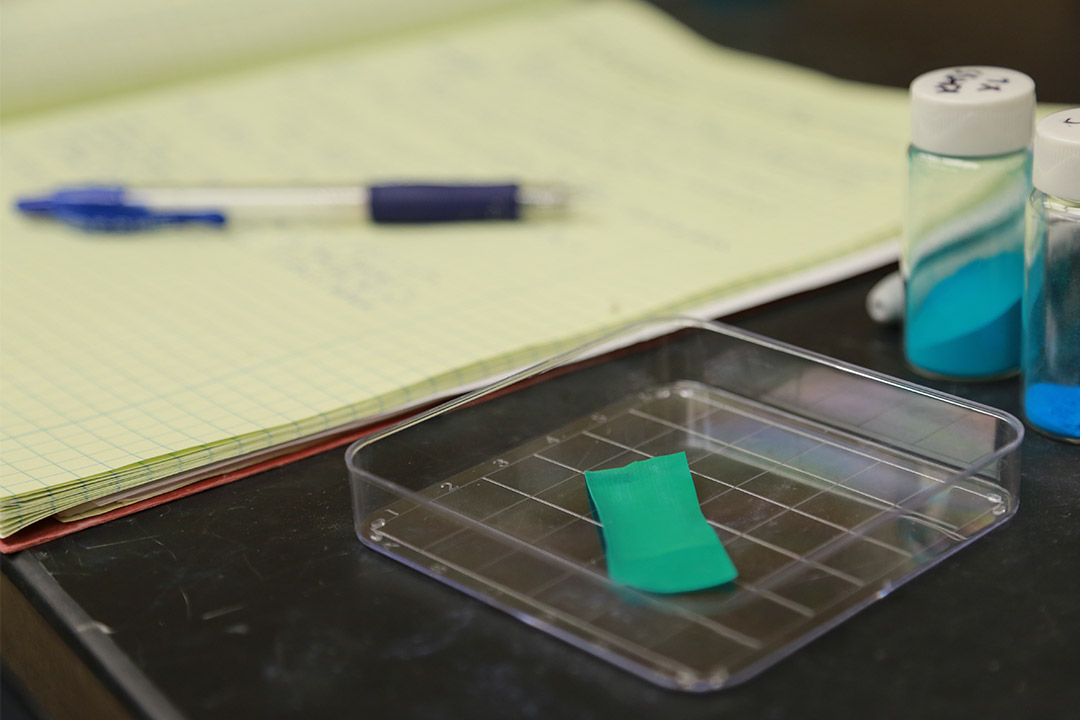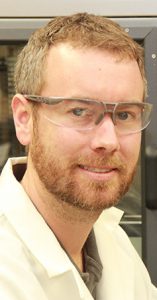// NEWS RELEASE
Stabilizing Metal Organic Frameworks
CCDC Chemical Biological Center scientist one step closer to material incorporation
CCDC Chemical Biological Center Public Affairs | January 13th, 2020
Stabilizing Metal Organic Frameworks
CCDC Chemical Biological Center scientist one step closer to material incorporation
DEVCOM CBC Public AffairsJanuary 13th, 2020

Peterson’s completed MOF and polymer film with improved dispersion.
Making warfighters lighter, faster and more lethal ranks high on the modern Army’s list of priorities and Greg Peterson hopes to contribute to this goal through chemistry. Peterson, a research chemical engineer at the U.S. Army Combat Capabilities Development Command (CCDC) Chemical Biological Center, works with metal organic frameworks (MOFs), crystalline materials with the ability to react with and decontaminate toxic substances and chemical warfare agents.
Depending on the mission, a Soldier carries about 75 pounds of gear that includes head, weapon and body subsystems. That burden may increase with the complexity of the mission. When facing possible chemical exposure, a breathing apparatus and other protective equipment can encumber warfighters, potentially making them less effective.
It’s Peterson’s job to figure out how to protect warfighters while decreasing their overall equipment weight.
Part of an In-house Laboratory Independent Research (ILIR) project and funded by the Defense Threat Reduction Agency (DTRA), Peterson, working with Professor Thomas Epps, III at the University of Delaware, has found a more secure method to integrate MOFs with polymers.
“Basically, all equipment the warfighter wears is polymer based,” Peterson said. “All clothing is made from polymers. Rubber masks, boots and gloves are all polymers as well. Kevlar, the material used in bullet proof vests, is a polymer. So if we can modify these systems to get us chemical and biological protection while retaining their underlying structural properties – that is a win.”
MOFs are active against chemical warfare agents, and polymers are a conduit to incorporating that activity into textiles and other protective gear. Putting the two substances together makes sense – except they make messy connections.
“They aren’t similar enough so they create defects at the interface,” Peterson explained.
Those defects or gaps at the interface allow opportunities for chemicals to break through the MOFs’ layer of protection. Besides the unsteady relationship between MOFs and polymers, MOFs present another challenge.
“The problem with the MOF we’re working with, CuBTC, is that it is not stable to moisture. If we used it as a filter it would constantly be exposed to moisture because there is humidity in the air and moisture in the breath of the warfighter, the structure of the MOF would break down.” If woven in a suit, the MOF would also break down when exposed to humidity or sweat.
While Peterson didn’t quite stumble upon a solution, he does admit that solving the problem came to him serendipitously.
“I didn’t set out to solve this problem,” Peterson said. “Originally, I focused on being able to integrate CuBTC easier with rubber.”
He had previously come up with methods that solved the MOFs moisture instability, but it added complexity to the process of MOF manufacturing, requiring an extra step or extra material to stabilize.
“Here, we have a very simple way of modifying the material during the MOF manufacturing process,” he said.
Made of metal nodes that are connected by organic linkers, Peterson says tuning the nodes allows researchers to change the pore structure and size, the surface area, functionality and chemistry of the material. “They are really good in terms of being able to target certain chemical interactions. In our case chemical warfare agents and toxic industrial chemicals.”
Peterson substituted one of the MOFs’ linkers, using an amine group link instead of a carboxylic acid one. “You can react the amine group and attach other molecules in a process called post synthetic modification.”
Because some polymers can be incompatible with the MOF, post synthetic modification for these types of materials is important.
“The idea behind the post synthetic modification in this case is you can modify the amine functional group with something that looks like a polymer,” Peterson explained. “When you mix the polymer and the modified MOF together they’ll have better interaction. The interface will be much more compatible.”
While attempting to create a breathable rubber, Peterson added the amine group and hydrophobic tails to the CuBTC believing it would make the CuBTC more amenable to integration of polymers. “We found out it was stabilizing the MOF as well. That’s actually a bigger deal.”
Peterson says there are two reasons why his findings are significant. First, ammonia is a chemical that is part of testing requirements for masks and collective protection filters. His research shows that the amine group stabilizes the MOF to moisture, yet it retains the same high ammonia reaction capacity. Second, the amine group makes the
MOF more compatible with polymers, allowing Peterson to move forward.
“We can begin conducting studies to see if the MOF will still block agent, wick moisture from surfaces like the skin and remain stable,” Peterson said.
Success in this area could benefit the warfighter in a number of ways such as providing a more efficient filter with a broader array of capabilities than current filters.
“Hopefully it leads to better, more efficient, more breathable suits which is a big concern these days,” Peterson said. “Currently, Soldiers wear the Joint Service Lightweight Integrated Suit Technology (JSLIST) personal protective equipment and it’s pretty burdensome. It doesn’t have extremely high moisture vapor transport, but has great protection against chemical warfare agents. Our research is a step in the right direction to more efficiently integrate materials that transport moisture very well, but also react with chemical warfare agents.”
Right now tests have been limited to 30 – 40 milligrams of CuBTC to determine the capacity of the material. Peterson’s next step is to simulate a full-scale filter in a test tube which he says has good scalability.
“Basically, we use the same air flow velocity and bed depth that would be in the main filter but using a lower flow rate. We have these correlations that go back decades that show very good comparison between the test tube and filter,” he said.
If the full-scale simulation goes well, Peterson will create prototype filters to use in gas masks.
“For filters, it could be huge,” Peterson said. “There has been interest expressed by a commercial company. There are companies that are scaling MOFs and are interested in our work. We’re still looking at what the range of capabilities are. We hope it’s going to be multi-functional and not just for ammonia. If it’s successful at filtering other chemicals, it would be a major breakthrough because then we’d get a material that solves two or three problems we have with current filters.
“If it looks really good then we’ll tackle this as another potential avenue for protective reactive suits and potentially a decontamination material to integrate into the sprayable slurry that the decontamination team is working on.”
The U.S. Army Combat Capabilities Development Command (DEVCOM) leads in the discovery, development and delivery of technology-based capabilities to enable Soldiers to win our nation’s wars and come home safely. DEVCOM is a major subordinate command of the U.S. Army Futures Command. The DEVCOM Chemical Biological Center is the Army’s principal research and development center for chemical and biological defense technology, engineering and field operations. The DEVCOM Chemical Biological Center is headquartered at Aberdeen Proving Ground, Maryland.

